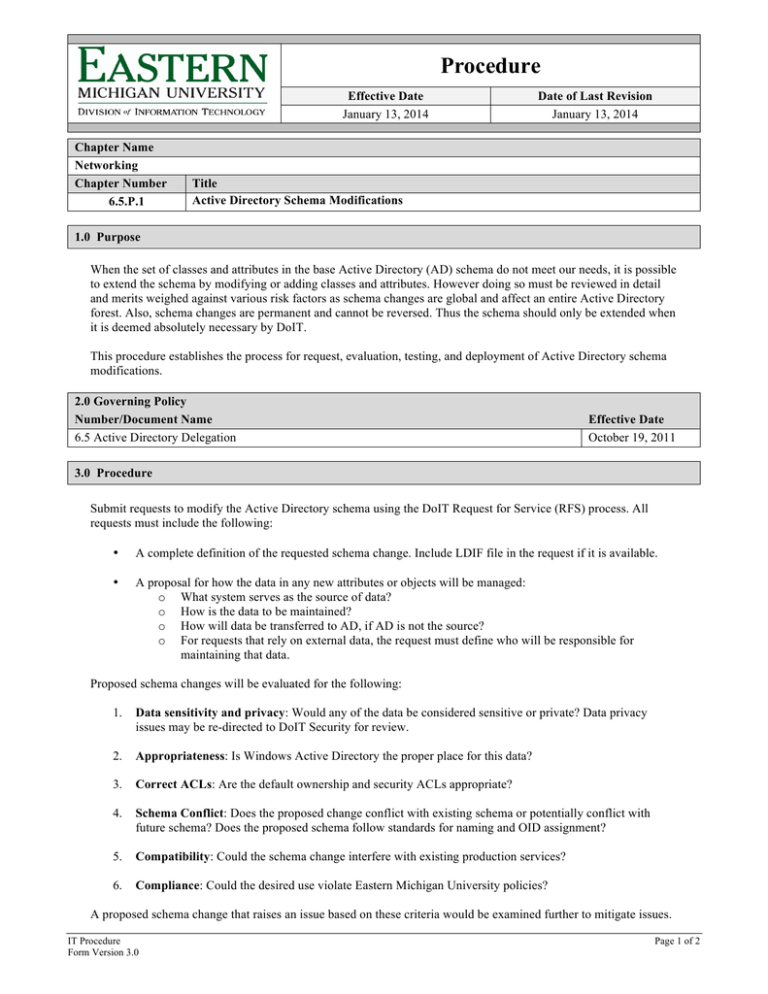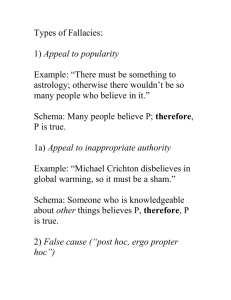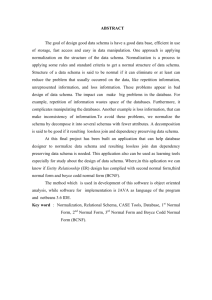Procedure
advertisement

Procedure Effective Date January 13, 2014 Chapter Name Networking Chapter Number 6.5.P.1 Date of Last Revision January 13, 2014 Title Active Directory Schema Modifications 1.0 Purpose When the set of classes and attributes in the base Active Directory (AD) schema do not meet our needs, it is possible to extend the schema by modifying or adding classes and attributes. However doing so must be reviewed in detail and merits weighed against various risk factors as schema changes are global and affect an entire Active Directory forest. Also, schema changes are permanent and cannot be reversed. Thus the schema should only be extended when it is deemed absolutely necessary by DoIT. This procedure establishes the process for request, evaluation, testing, and deployment of Active Directory schema modifications. 2.0 Governing Policy Number/Document Name 6.5 Active Directory Delegation Effective Date October 19, 2011 3.0 Procedure Submit requests to modify the Active Directory schema using the DoIT Request for Service (RFS) process. All requests must include the following: • A complete definition of the requested schema change. Include LDIF file in the request if it is available. • A proposal for how the data in any new attributes or objects will be managed: o What system serves as the source of data? o How is the data to be maintained? o How will data be transferred to AD, if AD is not the source? o For requests that rely on external data, the request must define who will be responsible for maintaining that data. Proposed schema changes will be evaluated for the following: 1. Data sensitivity and privacy: Would any of the data be considered sensitive or private? Data privacy issues may be re-directed to DoIT Security for review. 2. Appropriateness: Is Windows Active Directory the proper place for this data? 3. Correct ACLs: Are the default ownership and security ACLs appropriate? 4. Schema Conflict: Does the proposed change conflict with existing schema or potentially conflict with future schema? Does the proposed schema follow standards for naming and OID assignment? 5. Compatibility: Could the schema change interfere with existing production services? 6. Compliance: Could the desired use violate Eastern Michigan University policies? A proposed schema change that raises an issue based on these criteria would be examined further to mitigate issues. IT Procedure Form Version 3.0 Page 1 of 2 Testing requirements All schema updates will be tested in a development/test environment before being deployed into production. Prior to the start of testing, the requester will need to develop a test plan for confirming the functionality of the schema updates and applications. Depending on potential impact, DoIT will also develop a test plan for confirming compatibility. Once a test plan is in place, the schema will go to development. The development environment will have a subset of objects and will not have the full range of interoperability with campus infrastructure. This environment will be used to determine functionality of the changes and to develop any procedures needed for production rollout and support. Once the functionality test plans and basic compatibility tests are complete and a documented production rollout plan is approved, the schema will go to user acceptance testing phase on the test domain. Deployment of schema updates All updates to the user acceptance testing and production environments require notification of the Windows Infrastructure clients. These changes are only made during the regularly scheduled maintenance times. Schema changes are considered major changes because they cannot be completely rolled back and change management requests must schedule lead time accordingly. All schema changes will be documented. 4.0 Responsibility for Implementation The Director of Network and Systems services is responsibility for the implementation of this procedure. 5.0 Definitions Term Active Directory (AD) schema Class Object ACL LDIF OID 6.0 Revision History Description Policy Committee Approved by CIO IT Procedure Definition Contains formal definitions of every object class that can be created in an Active Directory forest. The schema also contains formal definitions of every attribute that can exist in an Active Directory object. A formal description of a discrete, identifiable type of object stored in the directory service. A unit of data storage in the directory service. Access Control List .. LDAP Data Interchange Format – A file format used to make changes to an LDAP. Object Identifier. Approval Date January 9, 2014 January 13, 2014 Page 2 of 2







